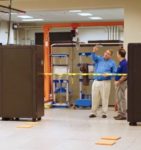Researchers are using supercomputers to model how contagions can spread onboard aircraft. Using Frontera’s GPU subsystem, the researchers were able to get the computation time down to 1.5 minutes. “Using the GPUs turned out to be a fortunate choice because we were able to deploy these simulations in the COVID-19 emergency. The GPUs on Frontera are a means of generating answers fast.”
Podcast: Supercomputing the Coronavirus on Frontera
Scientists are preparing a massive computer model of the coronavirus that they expect will give insight into how it infects in the body. They’ve taken the first steps, testing the first parts of the model and optimizing code on the Frontera supercomputer at the Texas Advanced Computing Center of UT Austin. The knowledge gained from the full model can help researchers design new drugs and vaccines to combat the coronavirus.
Podcast: How the Frontera Supercomputer will power research at UT Austin
In this podcast, Dr. Greg Fenves, President, the University of Texas at Austin describes how the new Frontera supercomputer at TACC will drive academic research. “The University of Texas at Austin has claimed a leadership role in supercomputing with the top academic system in the world, Frontera, located at the Texas Advanced Computing Center (TACC). The National Science Foundation awarded TACC $60 million for building and operating Frontera, the #5 fastest computer in the world according to the June 2019 Top500 rankings.”
Podcast: Inside TACC’s Frontera Supercomputer
In this Intel Chip Chat podcast, Dan Stanzione from TACC discusses the architecture and capabilities of Frontera, TACC’s newest HPC cluster. “Frontera’s architecture includes 8,000 servers, each powered by 2nd Generation Intel Xeon Scalable processors. The cluster includes hundreds of thousands of processing cores and a liquid-cooled infrastructure enabling a higher clock rate for even more performance.”
TACC Unveils Frontera – Fastest Supercomputer in Academia
Today TACC unveiled Frontera, the 5th most powerful supercomputer in the world. “Frontera has been supporting science applications since June and has already enabled more than three dozen teams to conduct research on a range of topics from black hole physics to climate modeling to drug design, employing simulation, data analysis, and artificial intelligence at a scale not previously possible.”
Frontera: The Next Generation NSF HPC Resource, and Why HPC Still isn’t the Cloud
Dan Stanzione from TACC gave this talk at the MVAPICH User Group. “In this talk, I will describe the main components of the award: the Phase 1 system, “Frontera”, the plans for facility operations and scientific support for the next five years, and the plans to design a Phase 2 system in the mid-2020s to be the NSF Leadership system for the latter half of the decade, with capabilities 10x beyond Frontera. The talk will also discuss the key role MVAPICH and Infiniband play in the project, and why the workload for HPC still can’t fit effectively on the cloud without advanced networking support.”
DDN EXA 5: Innovation at Scale
James Coomer gave this talk at the DDN User Group meeting in Frankfurt. “EXA5 brings our customers a whole new level of experience based on the Lustre filesystem. With huge performance boosts, better scaling properties and a strong appliance approach, this is Lustre like you’ve never seen it before. Fully featured, native file management, strong security, data integrity, container integration and a load more. James will talk about the major new features in EXA5 and about how we manage flash for complex and difficult use cases.”
Mellanox HDR 200G InfiniBand is powering next-gen supercomputers
Today Mellanox announced that HDR 200G InfiniBand is powering the next generation of supercomputers world-wide, enabling higher levels of research and scientific discovery. HDR 200G InfiniBand solutions include the ConnectX-6 adapters, Mellanox Quantum switches, LinkX cables and transceivers and software packages. With its highest data throughput, extremely low latency, and smart In-Network Computing acceleration engines, HDR InfiniBand provides world leading performance and scalability for the most demanding compute and data applications.
For the first time, all TOP500 Systems are Petaflop Machines
The latest TOP500 list of the world’s fastest supercomputers is out today, marking a major milestone in the 26-year history of the list. For the first time, all 500 systems deliver a petaflop or more on the Linpack benchmark. “Frontera at TACC is the only new supercomputer in the top 10, which attained its number five ranking by delivering 23.5 petaflops on HPL. The Dell C6420 system, powered by Intel Xeon Platinum 8280 processors.”
Video: How Intel Data-Centric Technologies will power the Frontera Supercomputer at TACC
In this video, researchers from the Texas Advanced Computing Center describe how Intel data-centric technologies power the Frontera supercomputer, which is currently under installation. “This system will provide researchers the groundbreaking computing capabilities needed to grapple with some of science’s largest challenges. Frontera will provide greater processing and memory capacity than TACC has ever had, accelerating existing research and enabling new projects that would not have been possible with previous systems.”












